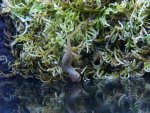Azhael
Site Contributor
- Joined
- May 7, 2007
- Messages
- 6,645
- Reaction score
- 103
- Points
- 0
- Location
- Burgos
- Country
- Spain
- Display Name
- Rodrigo
I recently acquired 5 N.v.viridescens, which by they way look much better now (they had a little bloating episode), and i can´t help but notice they are not red as i had imagined they would be xDDDD
This may be a completely stupid question but this is my first contact with this species, so i ignore lots of things about them, is it normal that the juveniles have adult coloration???
I´m guessing as they age the red coloration will appear, after all they are freshly morphed.
However, the guy i bought them from, told me i could keep them aquatic if i wanted to. Which i didn´t, because i´ve had a couple of bad experiences involving juveniles and water in the past, so i´m not going to take the risk.
Could that mean, though, that there´s a chance they will retain this green coloration?
This may be a completely stupid question but this is my first contact with this species, so i ignore lots of things about them, is it normal that the juveniles have adult coloration???
I´m guessing as they age the red coloration will appear, after all they are freshly morphed.
However, the guy i bought them from, told me i could keep them aquatic if i wanted to. Which i didn´t, because i´ve had a couple of bad experiences involving juveniles and water in the past, so i´m not going to take the risk.
Could that mean, though, that there´s a chance they will retain this green coloration?



